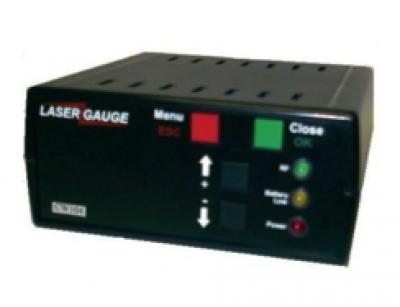
The LG4101 wireless controller is the most lightweight and compact of the LaserGauge® controllers and is ideally suited for use at fixed or roving inspection stations. A PC running the LGWorks Run-Time software communicates with the LG4101 over a 2.4GHz or 900MHz wireless RF signal and computer graphics guide the operator or operators through each measurement.
The LG4101 can be used with the controller-based HS305, HS306, HS602 and HS610 model sensors.
Wireless Communications – A 2.4GHz or 900MHz RF transceiver provides the communication link between the LG4101 and a base computer. While the controller’s transceiver is embedded inside the controller housing, the base transceiver is a stand-alone component, the size of a computer mouse plus a 5" antenna, and the transceiver connects to the base computer via a serial port. It requires an 110V power source. The communication range between the transceiver and the controller is approximately 100 feet.
Inspection Routines – The LGWorks Run-Time software sends commands through the RF transceiver to the LG4101, giving it the set-up information needed for each measurement in the inspection routine. Commands to the LaserGauge® system include messaging displayed on the sensor LCD and the virtual gauge settings used to make a measurement. As measurements are taken, results are sent back to the computer to be displayed on the monitor and saved to a data file.
User Interface – The system is designed for speed and simplicity of use. All menu options and routine functions are displayed on the sensor LCD and are accessed by using four buttons on the front panel of the controller. LED's on the controller provide information to the operator on power status, RF communication link, and any low-battery condition.
Audible Tones – Different tones are sounded from a speaker in the controller when a good scan is completed, a scanning error occurs or when a measurement is in-spec or out-of-spec.
Operator Instructions and Feedback – During the running of a routine, graphic and text information can be displayed on the base computer monitor, and optionally, on a larger, second monitor such as plasma display mounted over the production line. A photo of the part being inspected is displayed with an arrow pointing to the exact location for the measurement. Measured values can be displayed on the screen and indicators of in-spec and out-of-spec conditions identify each measurement location. Repairs needed to correct an out-of-spec condition can be printed on a label or displayed on the second monitor.
Battery Power – A rechargeable lithium-ion battery provides approximately four hours of constant operation. The battery weighs one pound and is carried in a pouch on the same belt as the controller.
100% Inspection – Automobile manufacturers prefer to verify the fit while a vehicle is still on the assembly line so that any adjustments that need to be made can be completed before the vehicle leaves the production area. A LaserGauge® system for inspecting the fit (gap and flush) of every vehicle on a moving assembly line is called a “Fit-Gate” station. Two operators run the Fit-Gate, one on either side of the assembly line using a LaserGauge® system to measure predetermined points on the vehicle.
Speed – An HS305 sensor used with the LG4101 controller can process a scan and return any number of values from that scan in less than one second. Because this is the fastest of all the LaserGauge® systems, it is the preferred system for use on the moving line at the Fit-Gate station. At a Fit-Gate, each operator can complete measurements at anywhere from eight to eighteen different locations on each side of the vehicle, depending on the speed of the line.